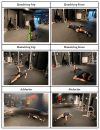Power Indices Through Rotational Inertial Devices for Lower Extremity Profiling and Injury Risk Stratification in Professional Soccer Players: A Cross-Sectional Study
- PMID: 40647690
- PMCID: PMC12249273
- DOI: 10.3390/diagnostics15131691
Power Indices Through Rotational Inertial Devices for Lower Extremity Profiling and Injury Risk Stratification in Professional Soccer Players: A Cross-Sectional Study
Abstract
Background/Objectives: Power indices may provide valuable information for performance and injury prevention in soccer players, so increasing the knowledge about them seems essential. Therefore, this study aimed to establish limb-specific normative values for flywheel-derived power indices in professional soccer players, while accounting for limb performance or ability, to explore the relationships between power indices across variables and to compare the power outcomes related to these indices between injured and non-injured players within four months post-assessment. Methods: Twenty-two male professional soccer players (age: 26.6 ± 4.6 years; competitive level: Belgian second division) were recruited from a single elite-tier club to participate in this cross-sectional diagnostic study. Participants underwent a standardized assessment protocol, executed in a rotational inertial device, comprising six unilateral exercises focused on the lower limbs: hip-dominant quadriceps (Qhip), knee-dominant quadriceps (Qknee), hip-dominant hamstrings (Hhip), knee-dominant hamstrings (Hknee), adductor (Add), and abductor (Abd). The testing session incorporated a randomized, counterbalanced design, with each exercise comprising two sets of eight maximal concentric-eccentric repetitions per limb. Leg dominance was operationally defined as the self-reported preferred limb for ball-striking tasks. Power indices were calculated from these exercises. Results: No significant differences in flywheel-derived power indices were found between limbs or between injured and non-injured players. However, significant correlations between indices were found in all power variables, with the Qhip:Qknee and Hhip:Hknee concentric ratios emerging as the most clinically actionable biomarkers for rapid screening. Conclusions: These results suggest the necessity of including more variables for injury prediction. Moreover, power indices could be considered based on the classification of limbs as "strong" or "weak".
Keywords: dominant limb; injury prevention; lower musculoskeletal strength; power indices; professional soccer players.
Conflict of interest statement
The authors declare no conflicts of interest.
Figures


Similar articles
-
Comparative Analysis of Mechanical Variables in Different Exercises Performed with a Rotational Inertial Device in Professional Soccer Players: A Pilot Study.J Funct Morphol Kinesiol. 2025 Jul 18;10(3):279. doi: 10.3390/jfmk10030279. J Funct Morphol Kinesiol. 2025. PMID: 40700215 Free PMC article.
-
[Volume and health outcomes: evidence from systematic reviews and from evaluation of Italian hospital data].Epidemiol Prev. 2013 Mar-Jun;37(2-3 Suppl 2):1-100. Epidemiol Prev. 2013. PMID: 23851286 Italian.
-
Knee orthoses for treating patellofemoral pain syndrome.Cochrane Database Syst Rev. 2015 Dec 8;2015(12):CD010513. doi: 10.1002/14651858.CD010513.pub2. Cochrane Database Syst Rev. 2015. PMID: 26645724 Free PMC article.
-
Home treatment for mental health problems: a systematic review.Health Technol Assess. 2001;5(15):1-139. doi: 10.3310/hta5150. Health Technol Assess. 2001. PMID: 11532236
-
Discriminative validity of summarized hip and knee angular accelerations for lower extremity training load quantification in male soccer players during a standardised training drill.Sci Med Footb. 2025 Feb;9(1):59-67. doi: 10.1080/24733938.2023.2290083. Epub 2023 Dec 7. Sci Med Footb. 2025. PMID: 38059842 Free PMC article.
Cited by
-
Comparative Analysis of Mechanical Variables in Different Exercises Performed with a Rotational Inertial Device in Professional Soccer Players: A Pilot Study.J Funct Morphol Kinesiol. 2025 Jul 18;10(3):279. doi: 10.3390/jfmk10030279. J Funct Morphol Kinesiol. 2025. PMID: 40700215 Free PMC article.
References
-
- Mokha M., Sprague P.A., Gatens D.R. Predicting Musculoskeletal Injury in National Collegiate Athletic Association Division II Athletes from Asymmetries and Individual-Test versus Composite Functional Movement Screen Scores. J. Athl. Train. 2016;51:276–282. doi: 10.4085/1062-6050-51.2.07. - DOI - PMC - PubMed
LinkOut - more resources
Full Text Sources

